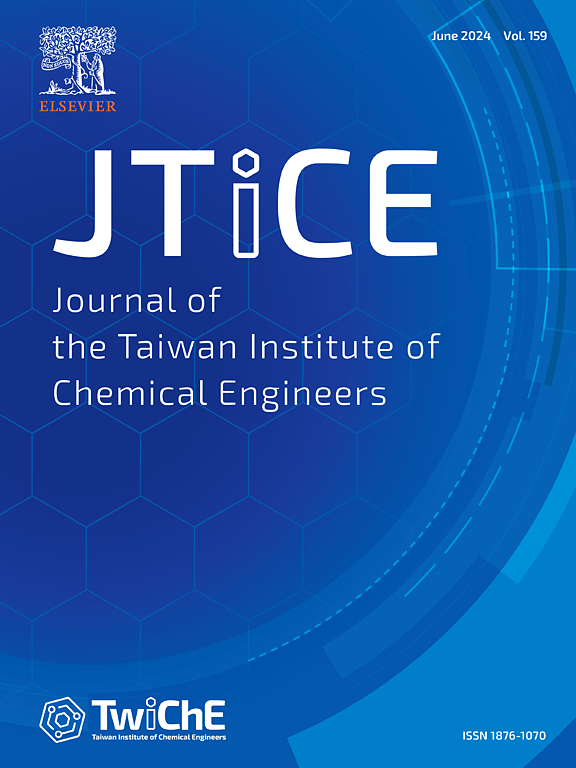Design of impeller blades for fluid laminar mixing in an unbaffled stirred reactor
IF 5.5
3区 工程技术
Q1 ENGINEERING, CHEMICAL
Journal of the Taiwan Institute of Chemical Engineers
Pub Date : 2025-03-13
DOI:10.1016/j.jtice.2025.106077
引用次数: 0
Abstract
Background
Many studies reported that the isolated zones are obstacles for the fluid laminar mixing process. The key to intensify the laminar mixing process lies in minimizing or eliminating the isolated zone while maximizing the chaotic mixing zone. In this work, dislocated fractal impeller (DF impeller) was applied to minimize the isolated zone and maximize the chaotic mixing zone for fluid laminar mixing process.
Methods
The mixing performance of dislocated pitched-blade impeller (DPB impeller) and DF impeller were explored through numerical simulation and experimentation.
Significant findings
Results showed that the impeller blades with dislocated fractal structure design resulted in a reduction in power consumption and power number compared to the straight impeller blades with the same blade area. Meanwhile, this design could improve the shear action of impeller blade edges on the fluid, enhance the radial and axial velocity, and minimize the pressure differential between its front and rear sides while reducing the recirculation zone behind the impeller blades compared to straight impeller blades under the same operating conditions. In addition, DF impeller could decrease mixing time, reduce the isolated zone and increase the chaotic mixing zone compared with DPB impeller under the same operating conditions.

无挡板搅拌反应器中流体层流混合叶轮叶片的设计
许多研究报道孤立带是流体层流混合过程的障碍。强化层流混合过程的关键在于最小化或消除隔离区,同时最大化混沌混合区。在流体层流混合过程中,采用位错分形叶轮(DF叶轮)最小化隔离区,最大化混沌混合区。方法通过数值模拟和实验研究了位错俯仰叶片叶轮(DPB叶轮)和DF叶轮的混合性能。结果表明:采用位错分形结构设计的叶轮叶片与相同叶面积的直线型叶轮叶片相比,功率消耗和功率数均有所降低;同时,该设计可以改善叶轮叶片边缘对流体的剪切作用,提高径向速度和轴向速度,减小叶轮前后侧压差,同时在相同工况下,与直叶轮叶片相比,减少叶轮叶片后的再循环区。在相同工况下,与DPB叶轮相比,DF叶轮可以缩短搅拌时间,减少隔离区,增加混沌混合区。
本文章由计算机程序翻译,如有差异,请以英文原文为准。
求助全文
约1分钟内获得全文
求助全文
来源期刊
CiteScore
9.10
自引率
14.00%
发文量
362
审稿时长
35 days
期刊介绍:
Journal of the Taiwan Institute of Chemical Engineers (formerly known as Journal of the Chinese Institute of Chemical Engineers) publishes original works, from fundamental principles to practical applications, in the broad field of chemical engineering with special focus on three aspects: Chemical and Biomolecular Science and Technology, Energy and Environmental Science and Technology, and Materials Science and Technology. Authors should choose for their manuscript an appropriate aspect section and a few related classifications when submitting to the journal online.

 求助内容:
求助内容: 应助结果提醒方式:
应助结果提醒方式:


